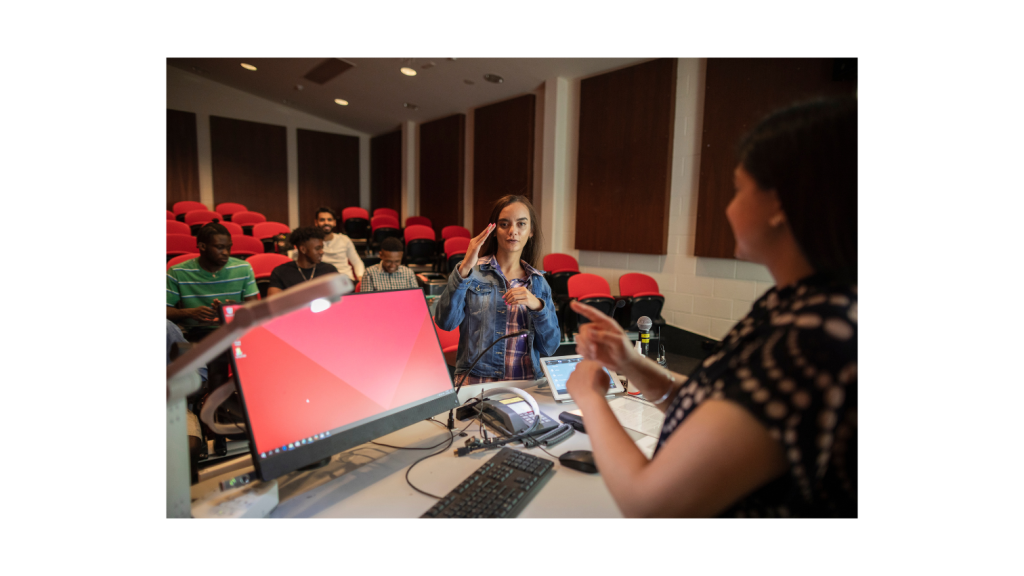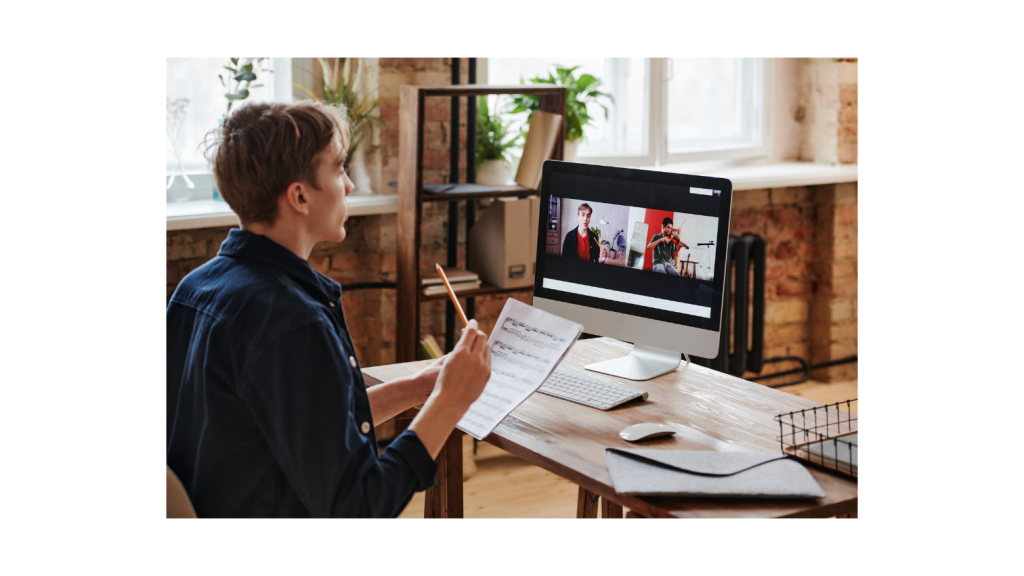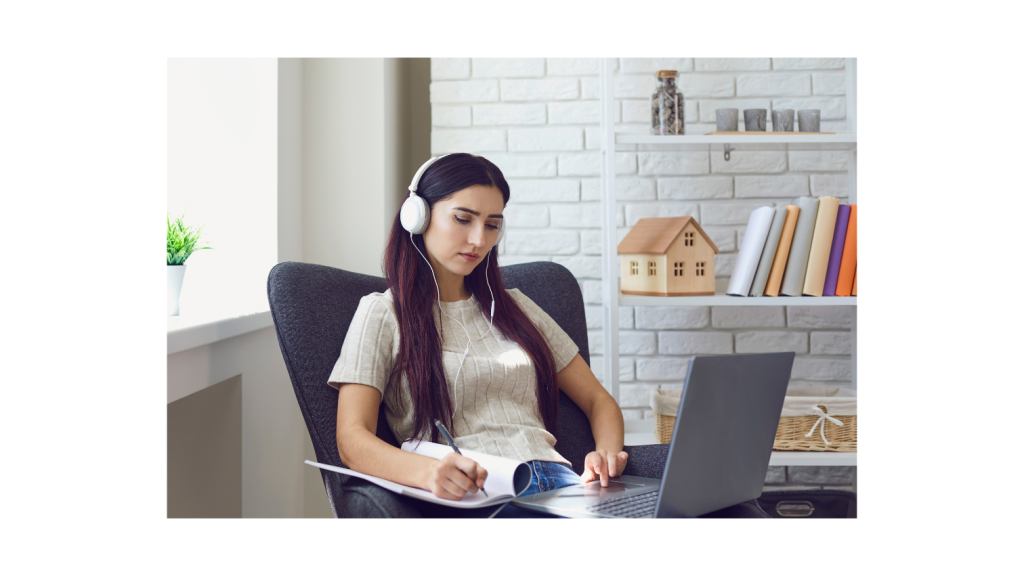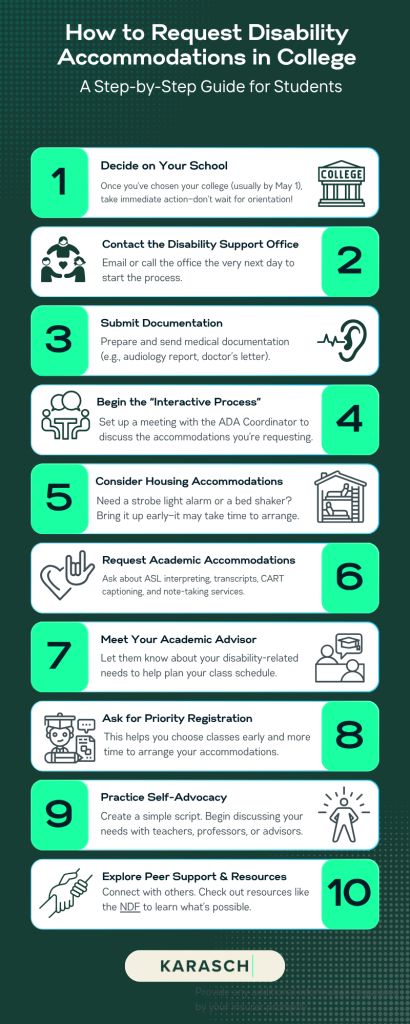College Accommodations 101: What Every Student with a Disability Needs to Know (Before Day One)
Starting college is a big leap—but if you’re a student with a disability, there’s even more to figure out. From knowing who to talk to, to understanding what services you’re entitled to, this guide will help you navigate the process with clarity and confidence.
Table of Contents
For students with disabilities, transitioning from high school to college isn’t just about moving away from home or choosing a major.
It’s about learning how to advocate for yourself in an entirely new system.
Maybe in high school, your parents or teachers helped organize your services. In college, you’re expected to take the lead and handle disability accommodations yourself. That shift can be overwhelming.
For example, you might have had an interpreter in every class before. But at college, you could be offered CART captioning instead.
Or maybe you were used to getting class notes from a peer, but now your school provides transcripts generated by AI software.
The point is: accommodations vary widely depending on the college. So does the process of requesting them.
Meet Your Advocate: The ADA Coordinator and Your Path to College Success
Colleges often mean well for their students—but they don’t always know their legal responsibilities under the ADA.
To bridge the knowledge gap, a certified ADA coordinator (also called the Accessibility Coordinator) becomes essential. They are your go-to contact for setting up accommodations and ensuring your rights are met.
This is exactly where Annie Tulkin’s expertise makes a difference.
Annie is an experienced ADA coordinator and the Founder of Accessible College.
She specializes in helping students with physical disabilities, chronic health conditions, and sensory impairments—including those who are Deaf or Hard of Hearing—transition successfully into college life.
You can watch the full interview with Annie here:
The Role of the ADA Coordinator and How a Student with Disabilities Can Get the Most Benefit
Whether you use a wheelchair, live with lupus or Crohn’s, or experience anxiety that limits classroom participation, you are entitled to support. The ADA coordinator is there to help you navigate what’s available and how to ask for it.
Types of accommodation range from priority class registration to housing adjustments.
Early Requests Matter
For example, you might need a strobe alarm in your dorm room if you’re deaf. Alternatively, you may want to request early access to your course schedule with the idea of booking interpreters or captioners on time.
But here’s what many students don’t know: colleges use different titles for their disability offices—like Accessibility Services or Academic Resource Centers. Make sure you search for alternative names when exploring colleges.
Self-Advocacy and Self-Disclosure
The process for getting accommodations isn’t automatic or managed by others.
Unlike high-school accommodations, now you have to self-disclose and become vocal about what you need. You might be asked to submit additional documentation, like audiology reports.
And, finally, you can meet with the Accessibility Coordinator to start what’s called the “interactive process”.
Solutions Available via the Role of the ADA Coordinator
Once you begin this process, you open the door to a wide range of services designed to meet your learning needs.
Here’s what might be available to you:
ASL Interpreting for DHOH People
If you communicate primarily through American Sign Language, you can request an ASL interpreter for your classes and events.
But be prepared—colleges don’t always have someone on staff and may need to contract through an outside provider.
This means timing is critical. Requesting early ensures better matches and consistent support.
Some universities, like Gallaudet University in Washington, D.C., are designed specifically for deaf and hard-of-hearing students and offer full ASL immersion.
But many mainstream institutions also provide ASL interpreting when requested through an ADA coordinator. California State University, Northridge (CSUN), which hosts the National Center on Deafness, is one example of a hearing university that consistently meets these needs.
ASL interpreting is particularly helpful in discussion-heavy subjects like literature, sociology, and education, as well as in science labs where fast-paced, real-time communication is crucial for safety and comprehension.

Live CART Captioning for College Students with Disabilities
CART (Communication Access Realtime Translation) provides live captioning of everything spoken in the classroom.
Students can follow along via a screen or personal device as a trained captioner transcribes the lecture in real time, often with over 98% accuracy.
This service is especially beneficial if you are deaf or hard of hearing but prefer reading over ASL, or for those who want a verbatim transcript for study purposes.
For example, the University of Arizona uses CART systems in large lecture halls, offering both in-person and remote captioning based on student needs.
CART captioning works best in lecture-heavy courses like political science, history, and law.
In these classes, continuous spoken instruction is the norm. Therefore, real-time visual reinforcement can make all the difference in comprehension.

Transcription or Note-Taking for Students Who Find Study Notes Helpful
If you struggle with a learning disability, anxiety, or just the speed of lectures, note-taking can be difficult.
Services like professional transcription or peer notes can help bridge the gap.
Note-taking accommodations are ideal for fast-paced or detail-heavy subjects like economics, psychology, and philosophy, where the flow of information is constant and easy to miss.
Meaning-for-Meaning Captioning with Summarized Notes
Some students prefer a summary of what was taught rather than a word-for-word transcript. That’s where meaning-for-meaning captioning comes in. This type of service distills the core concepts and helps reinforce learning. It’s especially useful in dense or fast-paced classes.
Harvard Extension School has explored note summaries for some of its continuing education offerings. However, many other schools don’t. Therefore, service providers can offer this format to students who request it.
This approach is well-suited for courses where interpretation and critical thinking matter more than memorizing the content word-for-word.

Getting Used to Remote Support Services
Many accessibility services are now offered remotely. That might mean your captioner, interpreter, or note-taker is not physically in the room with you.
This actually has advantages:
- Remote support can be discreet, efficient, and flexible.
- Allows for faster setup and more consistent quality—especially in smaller schools without in-house staff.
- Receive captions, transcripts, or interpretation directly on screen, often more discreetly than in-person services allow.
- Providers can be scheduled more efficiently.
- Transcript quality is consistent.
Remote services are especially effective for virtual classes, rural campuses, or students who value privacy and consistency in their accommodations.
Florida International University has integrated remote accessibility services using platforms like Zoom, Microsoft Teams, and proprietary learning management systems.

Universal Design for Learning: Accessibility That Benefits Everyone
While individual accommodations are essential, some colleges are going a step further by embracing Universal Design for Learning (UDL).
What is Universal Design for Learning?
UDL is an educational approach that proactively makes learning accessible for all students, with or without disabilities, and it is based on the idea that there’s no single “typical” learner.
By designing courses that offer multiple ways to engage with material, express understanding, and access information, UDL helps remove barriers before they become a problem.
For instance, instead of waiting for a student to request captioning, a UDL-aligned university might automatically caption all video content as part of its standard practice.
Schools Putting UDL Principles into Action
The University of Washington’s DO-IT program actively promotes UDL strategies, including flexible seating, digital course materials, and built-in captioning across platforms.
Oregon State University encourages faculty to design assignments and course layouts that consider a broad range of needs from the start.
UDL is especially helpful in large, diverse classes and introductory courses with students from many backgrounds. It also benefits students with temporary disabilities, English language learners, and those who simply learn better in non-traditional ways.
If you’re exploring colleges, ask about their commitment to Universal Design. A campus that integrates UDL shows not only that they care about accessibility—but that they understand accessibility is good design for everyone.
Conclusion: What You Need to Know (and Do) Before College Begins
The most common mistake students make?
Waiting too long. Or assuming that their IEP or 504 Plan will automatically carry over. Or feeling too embarrassed to ask.
You have nothing to be ashamed of.
Accommodations exist to help you thrive. What you need to do is:
- Understand what kinds of disability accommodations are available
- Think about what works best for your classes and your learning style
- Start the process early, ideally as soon as you accept your college offer
Here is a downloadable roadmap that lays all this out for you step-by-step.

And if you’re unsure about what to ask for or how to begin, reach out.
The team at Karasch is here to help you every step of the way—from securing ASL interpreters to setting up live captioning and note-taking.
We’ll make sure you’re not just accommodated—but supported.
Our Latest Resources
Request A
Call Back
Request A Call Back
Do you have additional questions?
Click here to meet your dedicated Client Relationship Manager.


